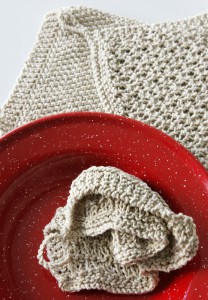Dish Cloth Duty – The Press, December 16th 2009
 With just a few days left before Christmas there is time still to create some last minute hand made gifts. People will appreciate the time and effort you spent making it. In an evening you can knit a cloth that can be used to wash those dirty dishes, or by using more refined yarn, a dirty face.
With just a few days left before Christmas there is time still to create some last minute hand made gifts. People will appreciate the time and effort you spent making it. In an evening you can knit a cloth that can be used to wash those dirty dishes, or by using more refined yarn, a dirty face.
The most suitable yarn is cotton; approximately 50metres of either 4 ply or 8 ply (double knitting). Pure cotton is best as it draws up water well. Acrylics and manmade fabrics are not suitable for this project. You might use cotton twine or knitting cotton for a dishcloth, and knitting cotton, bamboo, or a luxurious cotton and silk mixture for a facecloth.
You can make your cloth in any size you choose – remember, this is your design. Below is a basic pattern to give you some ideas to launch your own creativity.
Basic pattern:
Cast on 36 stitches on size 4mm needles.
Knit 4 rows.
Row 5 ~ 36 (or required size): K3, K central area pattern: eg Moss stitch, K3
Knit 4 rows, cast off.
You might change the size of needle, the type of yarn and the number of stitches. Remember, your swatch will be your guide.
Some patterns you might use for the central area of the cloth are:
Moss stitch, Waffle Stitch and Trinity stitch, in order of complexity.
Moss stitch is a two stitch pattern of K1, P1. Repeat this pattern for each subsequent row.
Waffle stitch is formed from multiples of three stitches and four rows.
Row 1: *K2, P1* repeat from * to the end of the row.
Row 2: *P2, K1* repeat from * to the end of the row.
Row 3: *K2, P1* repeat from * to the end of the row.
Row 4: K
Trinity stitch is formed from multiples of four stitches and four rows. Cast on 38 stitches for this pattern, as the central area requires 32 stitches (8 sets of a 4 stitch pattern), plus 3 stitches for each side edging. When you have knitted the central piece to the shape you require, it is best to end on row three of the pattern and knit the 4th row instead of purl and make it part of the edging. This balances out the ‘look’ of the pattern.
Row 1: * (K1,P1,K1) into the first stitch, P3tog)* repeat from * to the end of the row.
Row 2: P
Row 3: *P3 tog, (K1,P1,K1) into the next stitch* repeat from * to the end of the row.
Row 4: P
Trinity is so called because you make three stitches from one stitch then make one stitch from three stitches.
Another possibility is to knit an entire cloth in stocking stitch (knit one row, purl the next row) of any shape you want, or to add a picture or shape in the central area.
Maybe you could knit every row on the diagonal, starting with three stitches, adding one stitch at the beginning of each row until you reach the centre then decreasing one stitch at the beginning of each row until only three stitches remain and bind off.
Use a smoother stitch for a face cloth and a more complex stitch for a body cloth or pot scrubber. Knit a cloth, add a luxurious scented soap and, voila, you have a gift for that surprise guest.
Now it is your turn to play with the above suggestions, add your own ideas and tap into your own creative spirit to design unique, useful gifts for family and friends.